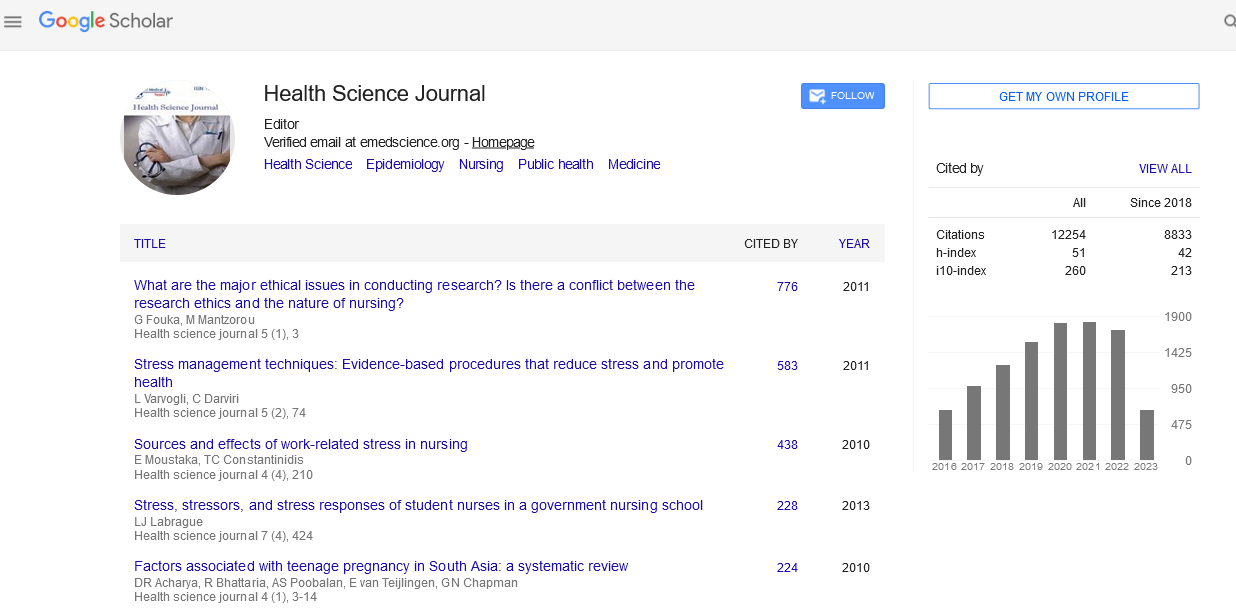Commentary - (2024) Volume 0, Issue 0
Climate Change and Global Health: Challenges and Pathways for Resilient Interventions
Kamal Singh*
Department of Environmental Health, Asian Institute of Medical Sciences, Delhi, India
*Correspondence:
Kamal Singh, Department of Environmental Health, Asian Institute of Medical Sciences,
Delhi,
India,
Email:
Received: 22-Jul-2024, Manuscript No. IPHSJ-24-15332;
Editor assigned: 24-Jul-2024, Pre QC No. IPHSJ-24-15332 (PQ);
Reviewed: 07-Aug-2024, QC No. IPHSJ-24-15332;
Revised: 14-Aug-2024, Manuscript No. IPHSJ-24-15332 (R);
Published:
21-Aug-2024, DOI: 10.36648/1791-809X.18.S11.004
Description
As climate change intensifies, the intersection between
environmental shifts and human health becomes increasingly
evident, placing new and complex pressures on global health
systems. Climate change does not merely threaten physical
environments; it exacerbates existing health disparities,
disproportionately affecting vulnerable populations who are
often least equipped to respond. Rising temperatures, worsening
air quality and the increasing frequency of extreme weather
events heighten the risk of respiratory diseases, vector-borne
infections and mental health conditions. To counter these
impacts, healthcare systems require innovative and effective
interventions designed to withstand the multifaceted pressures
posed by climate change.
Strained healthcare systems in climate-vulnerable
regions
One of the most pressing challenges in addressing climaterelated
health impacts is the lack of adaptive capacity in
healthcare systems, particularly in low-resource areas. Nations
facing financial constraints and technical limitations are often
hardest hit by climate impacts, and their healthcare systems are
typically under-resourced and ill-prepared to manage climatesensitive
diseases effectively. In these regions, rising
temperatures exacerbate respiratory diseases, with poor air
quality further complicating health outcomes. Health
infrastructure is frequently unequipped to deal with the
increased burden of climate-driven diseases, creating a vicious
cycle that places millions at heightened risk.
To build sustainability in healthcare systems, it is essential to
integrate climate considerations into public health policy. This
integration involves improving infrastructure, training healthcare
personnel in climate-specific responses and implementing
adaptive policies to accommodate fluctuating environmental
conditions. Furthermore, developing and deploying early
warning systems for climate-sensitive diseases, such as malaria
and dengue fever, can play an important role in reducing health
risks. By investing in predictive modeling and real-time
monitoring, healthcare systems can preemptively respond to potential outbreaks, minimizing the spread and impact of
climate-sensitive diseases.
The role of community engagement and localized
resilience
Communities are integral to developing sustainable solutions
to climate-related health challenges. When communities are
empowered to actively participate in health and environmental
initiatives, they become better prepared to handle climate
impacts. Community-based programs that focus on sustainable
agricultural practices, water conservation, and clean energy
alternatives not only help mitigate climate change but also
promote better health outcomes by reducing pollution and
ensuring reliable food and water supplies.
For instance, in areas prone to drought or floods, communitydriven
water conservation strategies can make a significant
difference. Such initiatives reduce dependency on unreliable
external resources, creating a sense of ownership and resilience
within communities. Moreover, education programs that raise
awareness about climate impacts and health promote behaviors
that reduce vulnerability to climate-sensitive conditions. These
grassroots efforts can create a foundation for broader, systemic
change and lessen the burden on larger healthcare systems.
Community Health Workers (CHWs) also play a critical role in
addressing climate-driven health risks at the local level. CHWs,
who often share linguistic and cultural ties with the communities
they serve, are well-positioned to provide health education and
disease prevention information in ways that resonate with local
populations. By training CHWs in climate resilience strategies,
countries can leverage this vital workforce to build climate
awareness and improve health outcomes in vulnerable areas.
Evidence-driven interventions for climate resistance
Data-driven decision-making is crucial in developing effective
climate-resilient health interventions. Leveraging data analytics
and technology, such as Geographic Information Systems (GIS),
can help track and analyze health trends linked to climate
change, allowing for timely and targeted interventions. For
instance, GIS technology can map areas at high risk for vector-borne diseases, enabling health departments to concentrate
resources and preventative measures in regions where
outbreaks are most likely to occur.
Collaboration with international organizations, such as the
World Health Organization (WHO), can further strengthen
evidence-driven interventions. By standardizing data collection
and sharing practices across countries, international partnerships
can create a more comprehensive picture of climate impacts on
global health. This collaborative approach ensures that all
nations, regardless of their resource level, benefit from shared
insights and best practices, ultimately strengthening global
health resilience against climate change.
Furthermore, implementing Health Impact Assessments (HIAs)
allows governments and health organizations to evaluate the
potential health consequences of climate-related policies and
projects. HIAs help identify vulnerable populations, assess the
effectiveness of proposed interventions, and adjust strategies to
mitigate adverse health outcomes. This proactive approach
ensures that health considerations are embedded into broader
environmental and economic policies, promoting a cross-sectoral
response to climate change.
Building global resilience through intersectoral
collaboration
The complex relationship between climate change and health
underscores the need for cross-sectoral collaboration. The
health sector alone cannot address the vast challenges posed by
climate change; partnerships with sectors such as agriculture,
energy, and transportation are essential. Intersectoral policies
that integrate health, environmental and socioeconomic factors
create a holistic approach to climate resilience, ensuring that
health interventions are supported by sustainable practices in
other areas.
For example, integrating climate effectiveness into urban
planning can have significant health benefits. Urban areas that
prioritize green spaces, for instance, reduce air pollution, provide
cooling effects during heatwaves, and offer recreational areas
that improve mental well-being. Similarly, sustainable
transportation policies that promote cycling and walking not
only reduce greenhouse gas emissions but also encourage
physical activity, contributing to better public health outcomes.
Global health organizations, including the WHO and the
United Nations, play an essential role in encouraging these
collaborations by promoting frameworks and guidelines that
align health and environmental policies. By bringing together
governments, non-governmental organizations, and private
sector partners, these organizations can mobilize resources,
drive policy innovation, and coordinate a unified response to
climate-related health challenges.
As climate change continues to reshape global health
landscapes, it is imperative to prioritize sustainability and
adaptability within healthcare systems. Integrating climate
considerations into health policy, encouraging community-based
adaptation and promoting intersectoral collaboration are critical
pathways for addressing the multifaceted challenges posed by
climate change. By focusing on proactive and evidence-driven interventions, we can create a future where healthcare systems
are equipped to protect vulnerable populations from the
growing health threats linked to environmental changes.
Addressing climate change and health as interconnected issues
will not only improve health outcomes but also build a
foundation for global resilience in the face of an uncertain
future.
Citation: Singh K (2024) Climate Change and Global Health: Challenges and Pathways for Effective Interventions. Health Sci J Vol.18 No.S11:004.





